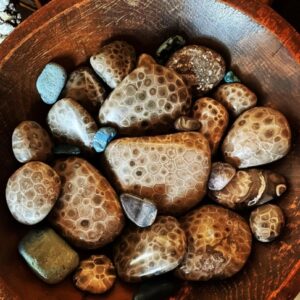If you’ve been collecting rocks for any length of time then you’ve definitely come across a Petoskey stone by now. These rocks are part fossil and part rock which makes them pretty interesting. The fossils captured in the stone are Colonial Coral (Hexagonaria percarinata). The coral colonies lived in a shallow sea that covered what’s now known as the Great Lakes.
When the coral died, some were covered with sediment, becoming part of an Alpena Limestone rock. These Limestone outcrops are along the coast of Little Traverse Bay near Petoskey, Michigan.
FAQ About Petoskey Stones
Petosky Stones can be distinguished by their unique exoskeleton structure. These stones consist of tightly packed, six-sided Corallites, which are the skeletons of once-living coral polyps. The center of every polyp was the mouth of these tiny creatures, and they contained tentacles that were used to catch food.
The hexagonal shape of each cell and the thin lines radiating from the dark eye in the center of the specimens are distinguishing features of these incredibly unique fossils.

Where Are Petoskey Stones Found?
Petoskey Stones were initially discovered in Petoskey, Michigan.
This particular fossil coral is only found in Alpena Limestone which makes the kind of rare and unique. If you’re looking to collect Petoskey Stones then you’ll need to locate the Alpena Limestone outcrops but they’re only found in the Little Traverse Bay area near Petoskey, Michigan.
There are at least seven species of the genus Hexagonaria found in Devonian rocks in Michigan. The Petoskey Stone genera of corals can be found in Iowa, Indiana, Illinois, Ohio, New York, Canada, England, Germany, and Asia. Upon casual inspection, these types of corals are difficult to distinguish from one another. If you want to tell them apart, you must become familiar with coral anatomy and related terms.
If you’re looking for a trusted online seller of Petoskey Stones, then check out Casey Cameron’s page
How Old Are Petoskey Stones?
Petoskey Stones are older than you think, 350 million years old to be exact. These tiny creatures lived in the warm shallow sea that covered Michigan.

How Are Petoskey Stones Formed?
At one point in time, Michigan was geographically near the equator and was covered by a warm shallow sea full of marine life. This marine life eventually died off and was covered with sedimentary rock but the skeletons of the coral left a void in the host rock and that is what you’re looking at when you find Petoskey Stones.
Here’s a more descript explanation of the sea animal found in Petoskey Stones. The soft living tissue of the coral was the polyp. The mouth was at the polyp’s center, and this dark spot, or eye, was filled with mud or silt that became petrified after falling into the openings. Surrounding those openings were the tentacles used to gather food to pull into the mouth.
You can blame glaciers for ripping the Petoskey Stones out of the sedimentary host rock and distributing them across the northwestern portion of Michigan’s lower peninsula. Some specimens can be found in the northeastern region as well.
Are Petsokey Stones Rare?
While Petoskey Stones aren’t incredibly rare, they’re definitely a fascinating rock that is worth keeping. They’re a great addition to any rock collection and most people find them interesting.

Petoskey Stones History
We’ve shared the creation and backstory of Petoskey Stones. Now we’ll share a bit of folklore behind them.
The story behind Petoskey Stones is ingrained into the state’s local history, reflecting the unique history of Michigan. It’s said that the meaning of the stone originates from a Native American name, Pet-O-Sega, which translates to Rising Sun, Sunbeams of Promise, or Rays of Dawn. Pet-O-Sega was also the name of an Ottawa Chief.
According to legend, the Chief was the child of a French fur trader who was a descendant of nobility and the daughter of a Native Chief. As Pet-O-Sega was born, the sun’s rays fell on his face. Which signified the glimmers of promise that his life would provide!
As the little chief grew up, he followed his father’s footsteps, becoming a wealthy fur trader. The wealth accumulated from this trade allowed Pet-O-Sega to purchase land for his tribe and enable him to act on his people’s behalf. Eventually, Pet-O-Sega married an Ottawa woman and had ten children. Before the Chief died in 1873, a growing city on Ottawa’s land was named in his honor. The town is now called Petoskey. The fossils were also named in the great Chief’s honor. The impact of this great Ottawa Chief has surpassed his lifetime and remains an integral part of Michigan’s exciting history.
This unique stone definitely has an interesting backstory and Petoskey Stones are one-of-a-kind specimens worth having.
- Identify Enstatite - March 12, 2024
- Identify Cerussite - March 3, 2024
- Identify Bytownite - February 18, 2024
